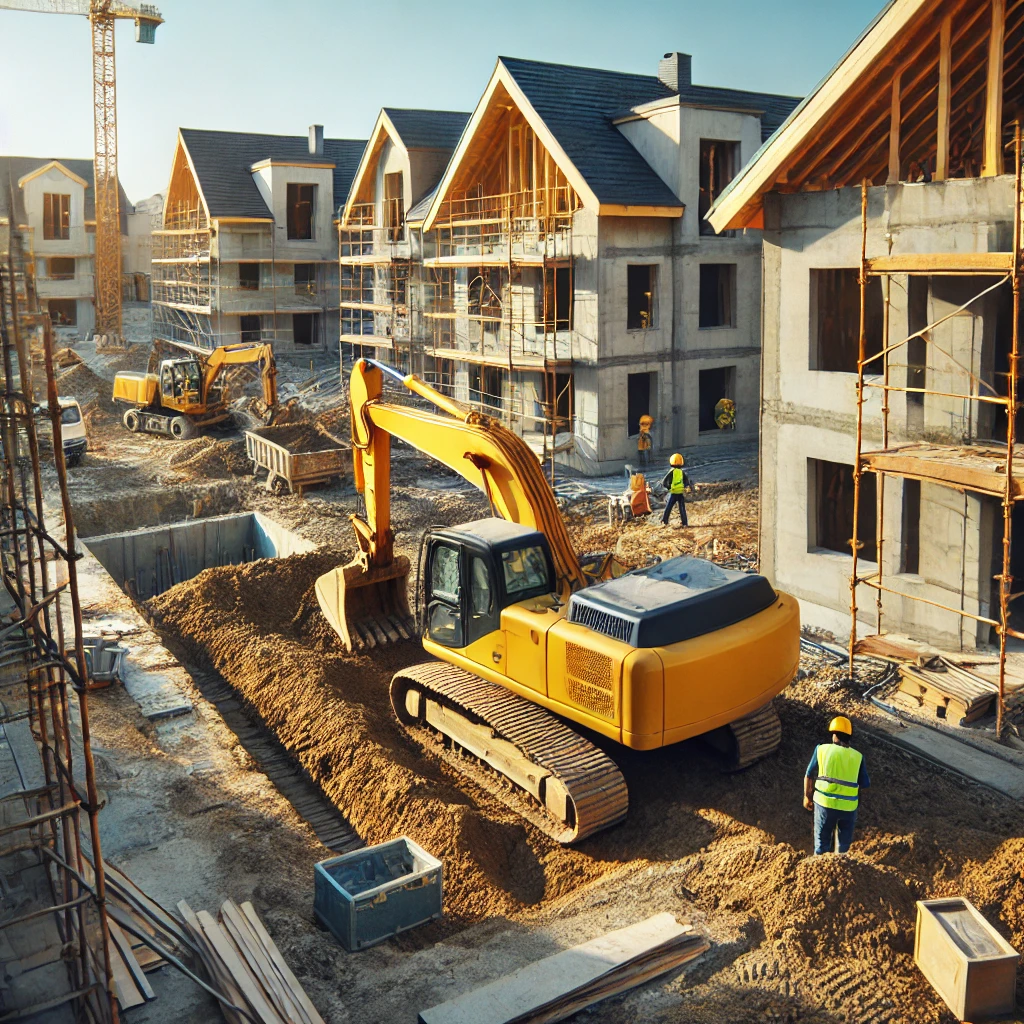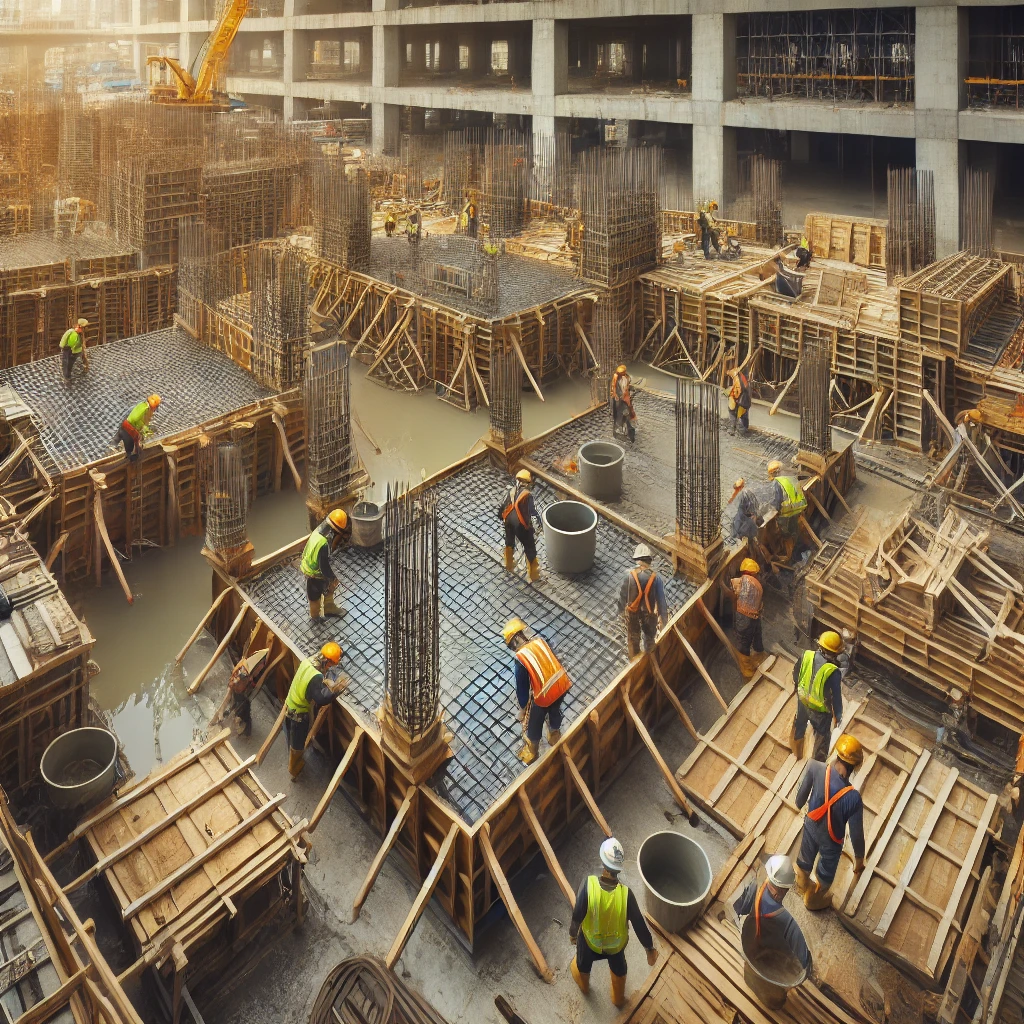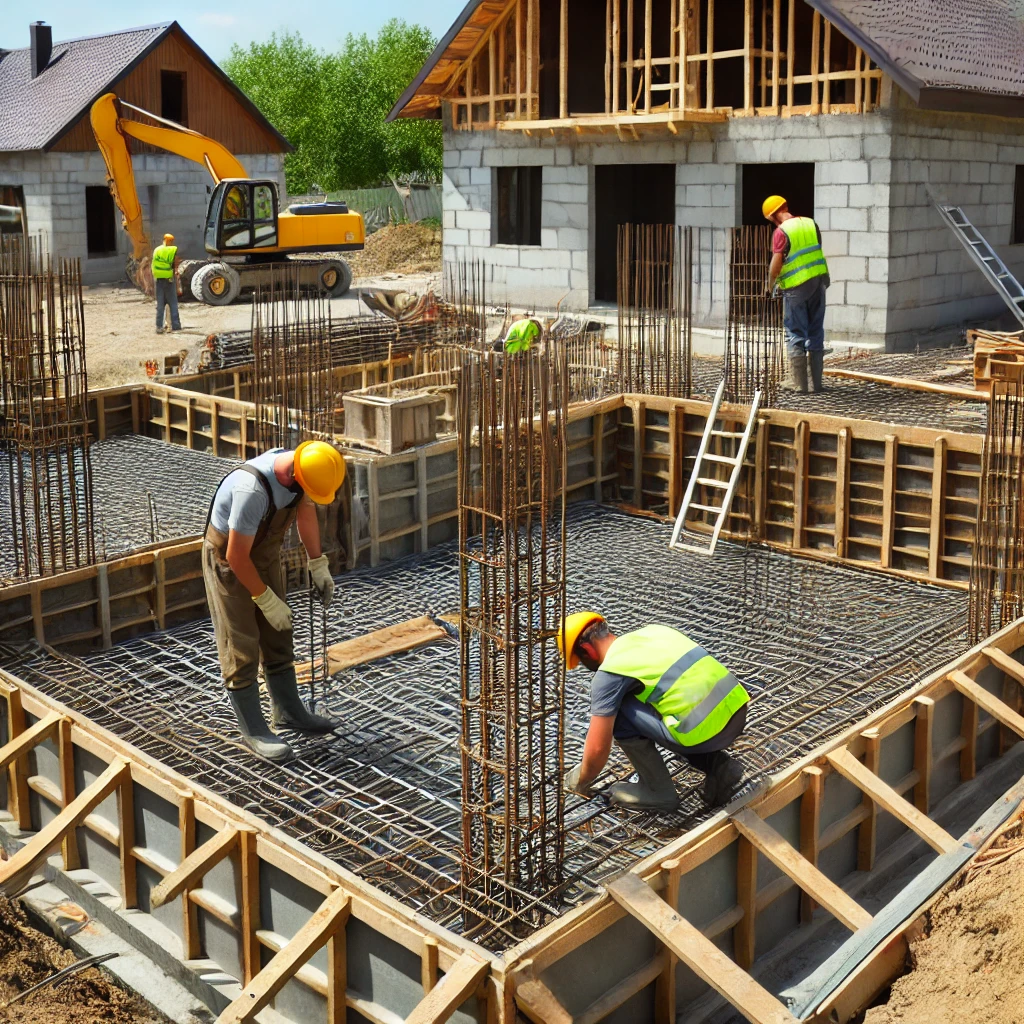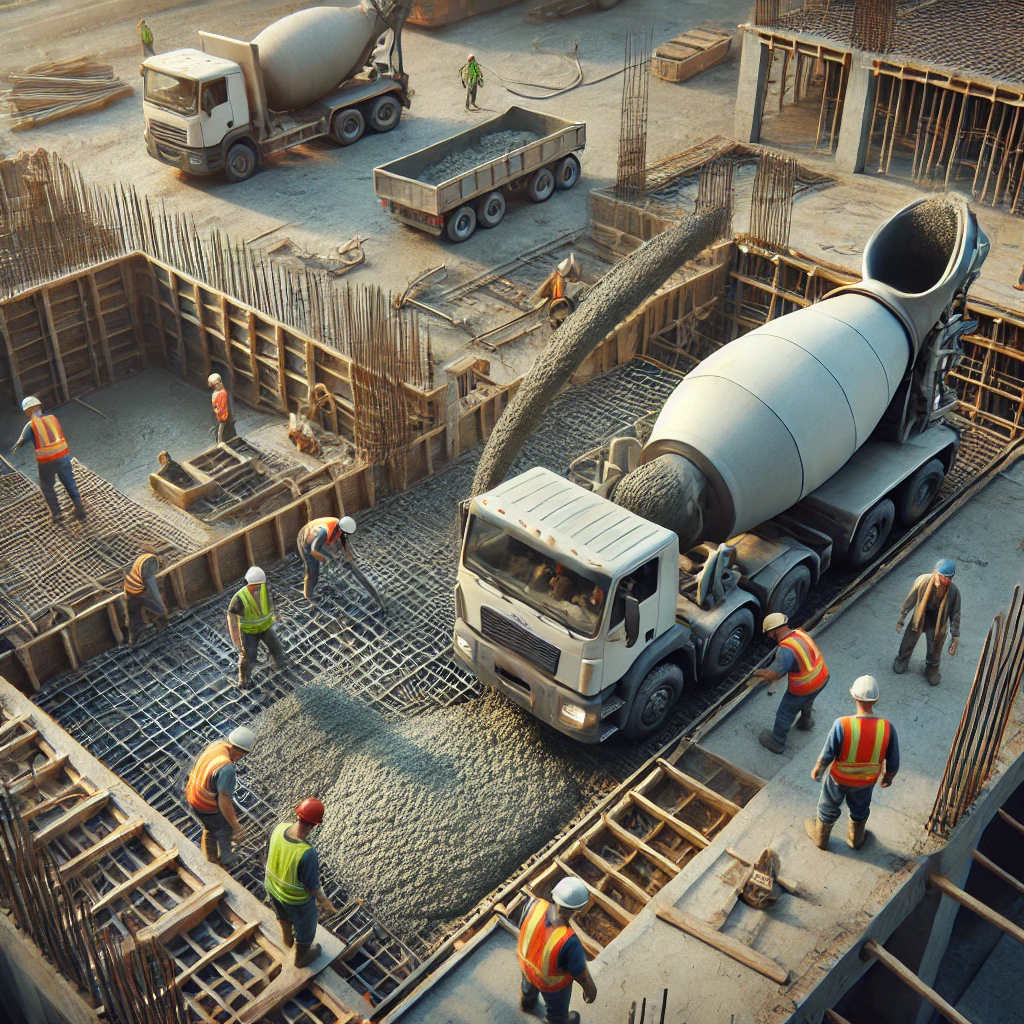
Check out our app!
Explore more features on mobile.
Foundation Work Tasks
This section walks you through the **essential steps** of laying a strong and stable foundation for your construction project. A well-built foundation ensures **structural integrity**, **prevents settling issues**, and provides a solid base for your home or building.
- Track Your Progress: Check off each stage of foundation work to stay on schedule.
- Stay Notified: Receive alerts for required inspections, concrete curing times, and project milestones.
- Step-by-Step Guidance: Get detailed instructions on soil preparation, footing installation, and foundation pouring.
- Prevent Costly Issues: Learn how to avoid common mistakes that can lead to foundation failures.
Whether you’re building a **concrete slab, crawl space, or basement foundation**, this section provides the knowledge and tools to **lay a strong, durable base** for your project.

Excavation Details
This section helps you track and complete the necessary tasks to prepare the site for construction. Use this to upload proof and take notes for each task.
Who to Hire:
Excavation Contractor, Site Engineer
Cost-Saving Tips:
- Rent excavation equipment instead of hiring a full crew for small-scale projects.
- Use excavated soil for backfilling instead of purchasing additional fill material.
Mark Excavation Areas According to the Blueprints
Mark excavation areas based on the provided blueprints.
Why It Matters: Ensures precise excavation, preventing errors that could affect foundation placement.
Who to Talk To: Site Engineer, Excavation Contractor.
Contact Information (E.G. People involved with Task)
Excavate Trenches for the Foundation
Excavate trenches as per foundation requirements.
Why It Matters: Proper trenching ensures structural integrity and prevents future foundation issues.
Who to Talk To: Excavation Crew, Foundation Contractor.
Contact Information (E.G. People involved with Task)
Remove Debris and Excess Soil
Remove any excess soil and debris to clear the site for construction.
Why It Matters: Keeps the construction site organized and prevents obstructions during foundation work.
Who to Talk To: Site Supervisor, Waste Disposal Service.
Contact Information (E.G. People involved with Task)
Formwork Installation
This section guides you through the process of setting up **temporary molds** for shaping the concrete during curing. Proper formwork ensures **structural accuracy, stability, and durability** throughout the construction process.
Who to Hire:
Concrete Contractor, Formwork Specialist
Cost-Saving Tips:
- Use reusable formwork materials like metal or treated plywood to save costs.
- Apply a **release agent** properly to prevent damage and allow for easy removal.
- Rent formwork panels and bracing instead of purchasing them for small projects.

Set Up Temporary Molds to Shape the Concrete
Install temporary molds to hold the concrete in place while it cures, ensuring the structure takes the correct shape.
Why It Matters: Ensures the concrete takes the correct shape and prevents structural weaknesses.
Who to Talk To: Concrete Contractor, Formwork Specialist.
Contact Information (E.G. People involved with Task)
Check for Alignment and Stability
Ensure that all formwork is properly aligned and stable to prevent any structural issues during pouring and curing.
Why It Matters: Prevents concrete misalignment, ensuring a level and structurally sound foundation.
Who to Talk To: Construction Foreman, Site Engineer.
Contact Information (E.G. People involved with Task)
Secure Formwork with Bracing
Use bracing and supports to secure the formwork and prevent movement during the pouring process.
Why It Matters: Prevents shifting or collapse, ensuring smooth and even concrete curing.
Who to Talk To: Formwork Installer, Concrete Contractor.
Contact Information (E.G. People involved with Task)

Reinforcement Placement
This section focuses on placing **steel reinforcement bars (rebar)** for structural strength. Follow these steps to ensure proper reinforcement placement and improve concrete durability.
Who to Hire:
Structural Engineer, Rebar Installer
Cost-Saving Tips:
- Buy rebar in bulk to save on material costs.
- Use pre-assembled rebar cages to reduce labor time and cost.
- Rent rebar cutting and bending tools instead of purchasing for one-time use.
Place Rebar as Per the Blueprint Design
Arrange steel reinforcement bars in the required positions as outlined in the blueprint.
Why It Matters: Proper placement of rebar reinforces concrete structures and prevents cracking or failure.
Who to Talk To: Structural Engineer, Rebar Installer.
Contact Information (E.G. People involved with Task)
Tie Rebar Intersections Securely with Wire
Ensure stability by securely tying rebar intersections with wire.
Why It Matters: Secure ties prevent rebar from shifting during concrete pouring, ensuring structural strength.
Who to Talk To: Concrete Contractor, Rebar Specialist.
Contact Information (E.G. People involved with Task)
Ensure Rebar Spacing Complies with Engineering Specifications
Verify the spacing of rebar meets the structural requirements to maintain integrity.
Why It Matters: Correct spacing ensures even concrete coverage, preventing weak points in the structure.
Who to Talk To: Structural Engineer, Site Supervisor.
Contact Information (E.G. People involved with Task)
Concrete Pouring
This section focuses on the process of **pouring concrete** into prepared forms. Proper pouring ensures **structural integrity, durability, and smooth finishing** for the foundation.
Who to Hire:
Concrete Supplier, Concrete Contractor
Cost-Saving Tips:
- Use **ready-mix concrete** to save time and reduce labor costs.
- Plan the pour **during cooler hours** to prevent premature drying.
- Rent concrete pumps and vibrators instead of purchasing for a one-time job.

Mix Concrete to the Specified Ratio
Ensure the concrete is mixed as per the specifications for optimal strength.
Why It Matters: Ensures durability, load-bearing capacity, and prevents premature cracking.
Who to Talk To: Concrete Supplier, Structural Engineer.
Contact Information (E.G. People involved with Task)
Pour Concrete Evenly into the Forms
Distribute concrete evenly into the prepared molds or forms.
Why It Matters: Prevents weak spots, ensuring even distribution and structural stability.
Who to Talk To: Concrete Contractor, Site Supervisor.
Contact Information (E.G. People involved with Task)
Vibrate Concrete to Remove Air Pockets
Use a vibrator to eliminate air pockets, ensuring a solid concrete structure.
Why It Matters: Prevents voids and increases the concrete's overall strength.
Who to Talk To: Concrete Contractor, Quality Inspector.
Contact Information (E.G. People involved with Task)

Concrete Curing
This section focuses on maintaining **proper curing conditions** for the concrete. Follow these steps to ensure the foundation reaches **optimal strength** and durability.
Who to Hire:
Concrete Contractor, Site Engineer, Quality Inspector
Cost-Saving Tips:
- Use **plastic sheeting or curing blankets** to retain moisture instead of expensive curing compounds.
- Plan concrete pours during **mild weather** to minimize additional curing efforts.
- Recycle curing materials like plastic sheets for multiple projects to reduce costs.
Cover the Foundation with Curing Blankets or Plastic Sheets
Cover the poured concrete with blankets or plastic sheets to maintain moisture and temperature.
Why It Matters: Helps the concrete retain moisture, preventing premature cracking and ensuring strength development.
Who to Talk To: Concrete Contractor, Site Supervisor.
Contact Information (E.G. People involved with Task)
Keep the Concrete Moist for 7–10 Days
Ensure continuous moisture for proper curing during the initial setting period.
Why It Matters: Proper moisture retention increases concrete durability and prevents shrinkage cracks.
Who to Talk To: Site Engineer, Quality Inspector.
Contact Information (E.G. People involved with Task)
Protect the Area from Extreme Weather Conditions
Shield the concrete from extreme temperatures and heavy rainfall.
Why It Matters: Prevents weather-related damage, ensuring the concrete cures evenly and reaches full strength.
Who to Talk To: Concrete Contractor, Weather Specialist.
Contact Information (E.G. People involved with Task)
Foundation Inspection
This section ensures the foundation **complies with engineering and safety standards**. Follow these steps to prepare for inspection and secure approval to proceed with construction.
Who to Hire:
General Contractor, Structural Engineer, Local Building Inspector
Cost-Saving Tips:
- Schedule multiple inspections in a **single visit** to minimize fees.
- Conduct a **pre-inspection walkthrough** with a contractor to catch and fix minor issues before the official review.
- Ensure all **paperwork and documentation** are prepared in advance to avoid reinspection delays.

Schedule an Inspection with Local Authorities
Arrange for an inspection by local authorities to verify the foundation.
Why It Matters: Confirms compliance with building codes and ensures a strong foundation for the structure.
Who to Talk To: Local Building Inspector, General Contractor.
Contact Information (E.G. People involved with Task)
Ensure All Requirements Are Met
Ensure that the foundation meets all the necessary requirements.
Why It Matters: Prevents costly modifications and ensures the foundation is built to last.
Who to Talk To: Structural Engineer, Site Supervisor.
Contact Information (E.G. People involved with Task)
Obtain Approval to Proceed with Framing
Get approval to move forward with the framing process.
Why It Matters: Ensures a seamless transition from foundation work to framing without delays.
Who to Talk To: General Contractor, Building Inspector.
Contact Information (E.G. People involved with Task)
Your Tools
Access your tools to manage tasks, update your profile, and track your progress.
Collaboration Feed
Engage with others, share ideas, and find inspiration in the Collaboration Feed.



